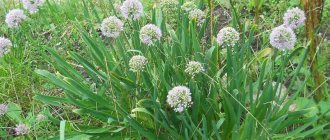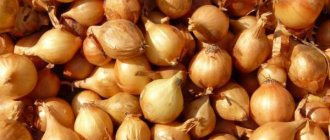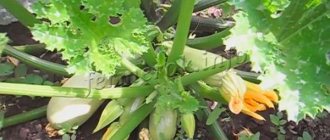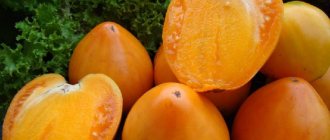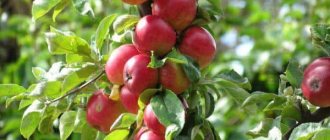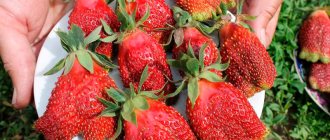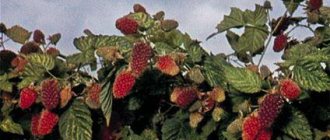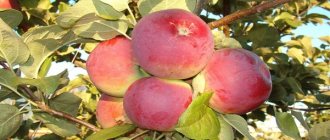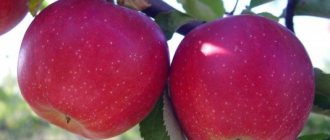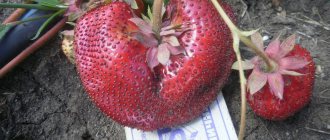Onion characteristics and yield
The main characteristics of the variety:
- large-fruited;
- the taste is semi-sharp;
- undemanding to agricultural technology;
- ripens early;
- stored for a long time in any form;
- you can grow winter onions.
The duration of the growing season for this variety is 115–120 days if the vegetable is grown from seed. When planting seedlings, the ripening period is reduced by almost 2 times, to 60–70 days. Being an unpretentious crop, the Stuttgarter Riesen onion, even with poor care, is capable of producing a yield of about 5 kg per 1 m².
When to plant: in spring or autumn?
The cultivation of this variety is possible with sets or seeds. The second option is characterized by the fact that the planting material reacts sharply to temperature changes and is able to lag behind in development.
Onion seeds Stuttgarter
Planting is performed both in autumn and spring. When sowing in autumn, smallish seedlings should be used, because during the storage period they dry out a lot. Autumn plantings must be mulched using humus or peat. The vegetable does not have special requirements for the composition of the soil, but gives preference to fertilized beds, the acidity level in which is neutral.
The best predecessors are cucumbers and tomatoes, legumes. Do not plant onions after potatoes. He will grow up tired and exhausted, in a harsh winter he may simply freeze out.
Choosing a seat for landing
Stuttgarter risen thrive best on acidic dry clay soils of a neutral type. For growing as a business, loose, light, fertile land is ideal. Do not plant it on acidic soils - this can negatively affect the yield of the crop. When planting onions for the winter, peat and humus must first be introduced into the soil in order to increase the fertility of the site.
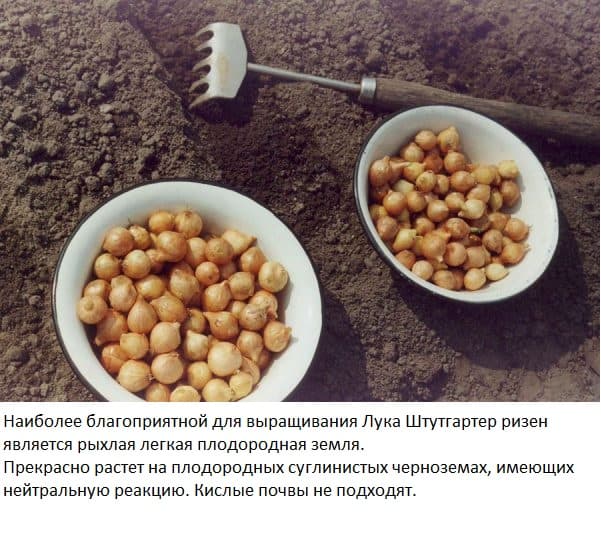
This culture must be placed in a well-ventilated, light place in which water never stagnates. Otherwise, the seedlings may rot at the end of autumn, and you will lose the entire crop. How to properly plant onion sets is described in this article.
The choice of planting material
This onion can be grown from both sets and seeds. The best quality is the set grown in Holland. However, even after purchasing such a product, it must be carefully inspected for damage and signs of rot. Any size of the fraction will do, but then the planting dates will be different.
Important! Before planting, any seed must be soaked in a weak solution of potassium permanganate.
Small sets should be planted in the fall - for winter cultivation. It is better to plant a large fraction in the spring. Onion seeds are also called "nigella". They need to be purchased only in specialized stores and be sure to pay attention to the expiration date.
Growing features
Often, seedlings are already being planted in open ground, but before that, onions must be grown from seeds. For this process, you need to prepare the soil and seeds in advance.
In the beginning, every beginner should know that the seeds must be chosen correctly. If you bought a pack of seeds and the expiration date ends in the same year, then these seeds are already old and you will only have one third of all seeds. It is best to take those seeds, the expiration date of which will expire in a few years.Then your chances of a great harvest will triple.
Before planting, they should be soaked in water for a day. This is a fairly simple method that will help you speed up the emergence of shoots. But don't forget about the soil. You can plant seeds as early as April, when the ground has already warmed up a little. The soil itself must be fertile and include loamy chernozem with a neutral reaction.
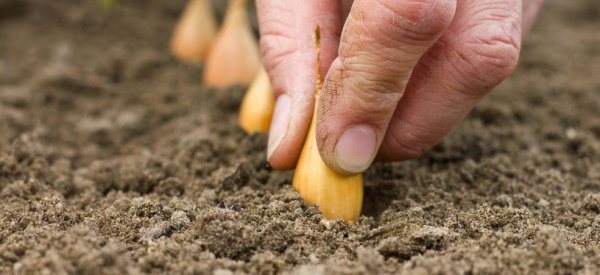

The depth of each seed hole should be no more than 4 centimeters, and the distance from 8-10 centimeters.
We fill the beds with soil and tamp it so that during the rain they are not carried away by the stream of water. You can use fertilizer as a top dressing, but even without it, the Stuttgarter Riesen onion will grow well. Remember to thin out the crop.
This sowing method has a number of advantages:
- Savings on the purchase of seedlings, because high-quality planting material is expensive.
- No hassle with where to store the sets.
- Avoiding bow shooting.
- Prevention of infection of the beds with diseases and pests that can be brought in due to poor-quality seeding.
If you need to grow a huge amount of onions, then this is the best method for you to use.
Growers use Biogrow's effective fertilizer to get a good harvest. This fertilizer is used for various plants, does not contain harmful chemicals, and can increase yields by fifty percent. It should be applied to the soil several times during the season.
Read next: Onion chalcedony variety description cultivation from seeds
Fertilizer Biogrow
This method can be used in autumn or early spring. On a previously prepared area, grooves are arranged across, between which a distance of about fifteen centimeters remains. The sowing depth is two centimeters, the gap is up to one and a half. After finishing sowing, the soil needs to be compacted a little.
For the convenience of distinguishing between crops, the seeds are mixed with a small amount of chalk.
Watering the beds with crops should not be immediately followed, so that the soil does not form a crust, which will be quite difficult for young shoots to break through. As soon as shoots appear, the planting must be thinned out.
Onion sprouts from seeds
The method is good because it does not require significant cash costs. And the seeds, grown by you yourself, give confidence that they do not contain diseases and pests.
Planting sevka
Experienced gardeners assure that planting onions with sevka before winter is not the best option, since in such cases there is a strong likelihood that the onion will go into the arrow. But if the decision is made to plant this way, then the smallest bulbs are used as planting material in order to minimize such risks.
It is better to plant seedlings in early spring.
The soil for this planting must be cool. It is believed that onions are planted with a set of onions two weeks after the garlic. Before planting, the material must be prepared:
- bulbs warm up for eight hours;
- then they should be soaked in warm water, adding a little potassium permanganate.
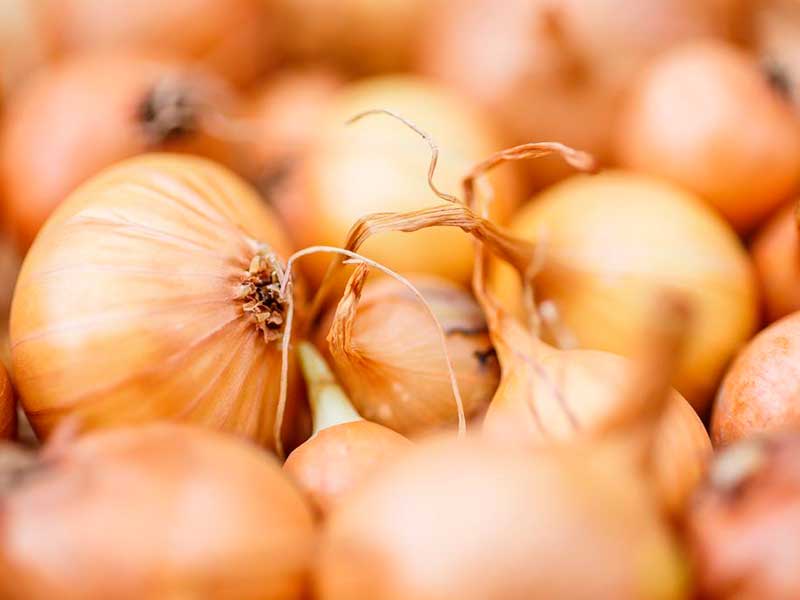

This landing method has its positive differences:
- in spring, shoots make their way to the soil surface quickly;
- the onion is developing actively, it is gaining excellent not only green mass, but also its underground part;
- a bow planted in winter does not give arrows;
- the ripening of the crop is faster.
Sevok will best of all take root in the "native" climate.
Feather landing
In this case, it is recommended to use onion turnips or rejected sets. The landing is tight. The bulbs are not covered with earth. The garden bed is watered, covered with plastic wrap. To speed up growth, you can feed the bed with a urea solution. Watering is carried out frequently.
The main characteristics of the variety
- The variety is mid-season.The period from emergence to the stage of technical ripeness lasts 93-95 days.
- The average bulb mass is 110-150 g.
- The bulbs are flat-round in shape.
- The variety was bred by German breeders.
- The color of the flesh of the bulbs is white.
- Bulbs are high in vitamin C.
- To obtain high yields and to shorten the ripening period, the variety is best grown with seedlings.
- The variety is characterized by high resistance to major diseases and pests.
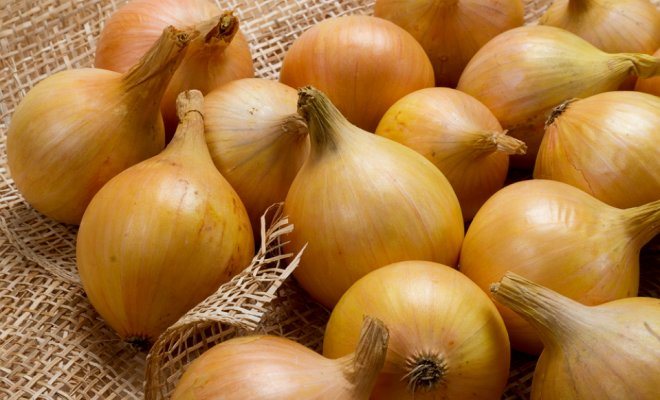

Growing from seeds for seedlings at home
Onions love sunlight, so you need to form a bed for it in a well-lit place. The area should also be well ventilated. A low temperature is not terrible for a vegetable, but only if the decrease is gradual, without sharp jumps.
It is best to grow onions in a moderate temperature range. It does not tolerate the variety if moisture stagnates at its roots. Therefore, the soil should be well drained and make sure that water does not collect in the garden in the spring. As soon as stagnant water is detected, it is necessary to immediately drain it.
Usually, if the Stuttgarter Riesen onion is grown from seeds, then they are planted in open ground at the end of April. You can plant a vegetable before winter in order to get a harvest in the spring. But some people prefer to first grow seedlings at home on a windowsill.
Seed preparation
The only thing that requires seed in preparation for sowing is disinfection. The solution of potassium permanganate should be slightly pink, and the seeds are soaked in it for a day. Then they are dried on a battery.
You can grow onions in deep seedling boxes. Ordinary juice containers (large) are also suitable: you need to cut out a wide side in them - you get a convenient waterproof container with a lid. Before the emergence of shoots, the container must be placed under the battery. After germination, it should be moved to the rack and provided with 12-hour daylight hours.
Seedling care
Seedlings moved to a lighted place should be watered regularly, as the topsoil dries up. The first feeding is carried out 7 days after germination. For these purposes, the liquid agent "Ideal" is used (2 caps per 1 liter of water). Subsequent applications of nutrients should be carried out at intervals of 1 week. The second time you should feed the sprouts with "Kemiroi Universal" and then alternate these 2 types of fertilizers.
If there is a glazed balcony, then after the temperature on it settles around 10 ° C, the seedlings can be transferred there for hardening. Around the beginning of April, you can take seedlings outside for a while, be sure to shade them. After 1 week of such procedures, you can begin to accustom the plants to sunlight.
It is advisable to plant seedlings in open ground after the 20th of May, when the soil warms up well and frosts stop. The cultivation bed must be prepared in April. It must be made on a small elevation (10 cm), and the soil must be mixed with wood ash and compost.
Read more: Caucasian wild persimmon description of the variety
Seedlings are planted in a row with an interval of 10-13 cm, and between rows - 13 cm.
Important! It is necessary to remove the covering material from the onion bed only in cloudy weather.
Fertilization of onions Stuttgarter Riesen
To obtain a good harvest, it is recommended to feed the plant and remove weeds in a timely manner, which take away nutrients from the onion. 2 weeks after the appearance of the first shoots, the onions are fertilized with urea at the rate of 25 g (1 tbsp. L.) Per 12 liters of water. A month after feeding, superphosphate and potassium salt are added. The third feeding is done during the period of bulb formation. Potassium salt and superphosphate are also used for this. Onion growth is greatly influenced by the autumn introduction of humus into the soil.Fresh mullein is strictly forbidden to use, since, when rotting, it not only burns the roots of the bulbs, but also prevents them from ripening. Another danger posed by fresh manure is parasites and pests.
As it grows, it is necessary to observe the changes that occur with the plant:
- With a lack of nitrogen, the feather turns white, from the photo you can see how the damaged stem will look. Gardeners often confuse this phenomenon with sunburn, but shading will definitely not help here. In addition to lightening the leaves, the bulb stops growing. It is necessary to apply fertilizing with nitrogenous fertilizers. If you plant onions in the ground where legumes grew before, then nitrogen deficiency can be avoided.
- With a lack of potassium, the feather withers and wilts. This is similar to a lack of watering, but even with regular watering of the ground, the leaves can wilt. Fertilize onions with potash fertilizers and prune wilted feathers if necessary.
- With a lack of phosphorus, the feather acquires a dark green color, characteristic of the variety, and dries. It all starts from the tips of the leaves, but over time, the plant dries up completely and dies. It is necessary to apply phosphorus-containing fertilizers.
Planting sevka
Those who cultivate this crop know that planting Stuttgarter Riesen onion sets in the fall is not very desirable, as there is a chance that this could cause the plants to shoot. In this case, it is recommended to take a small set for planting in the fall in order to avoid mistakes. Also, in the fall, you need to plant the bulbs in chilled soil and 1-2 weeks later than winter garlic. Soil requirements remain the same as when sowing seeds of this variety. There are several ways to prepare a set for planting:
- Before planting, it should be warmed up for about 8 hours at a temperature of 40-42 degrees. This can be done on a heating battery. To do this, you need to take a board with sides and it is desirable that the base is very thick, and scatter the onions over the entire surface.
- It is necessary to soak the onion sets in water, the temperature of which is 35-40 degrees. Also, potassium permanganate must be added to the water with the expectation that 1 gram of this substance must be added to a 5 liter bucket of water. In this solution, the sowing should be from 2 to 6 hours. After that, it is necessary to drain the water and put the bulbs on a film or burlap, and cover on top.
Before carrying out one of these procedures, the set must be sorted out and dried or diseased bulbs must be discarded. Over the past few years, it has become popular among gardeners to plant onion sets Stuttgarter Riesen before winter. The planting depth is 3-4 centimeters, and the distance should be 7 to 10 centimeters. There is a huge list of benefits if planted before winter:
- In spring, the sprouts will appear faster.
- The sprouts develop faster and become more powerful.
- There is no arrowing of the plant.
- Faster transforms into a marketable onion.
It is also necessary to know that sets brought from other climatic conditions do not take root in another zone. This is especially true of the onions that were grown in the south. Due to the fact that the length of the day there is further and is the main factor that it is difficult for them to form at all. If the bulbs are with increased arrowing, then this only means that the supplier did not observe the correct temperature regime during the winter storage period of the seed.
The onion variety Stuttgart is unpretentious, does not require special care. But you need to know what circumstances will improve its growth and increase yields.
The soil composition should be neutral in acidity. Onions, although they tolerate cold weather, feel better in warm or temperate climates.
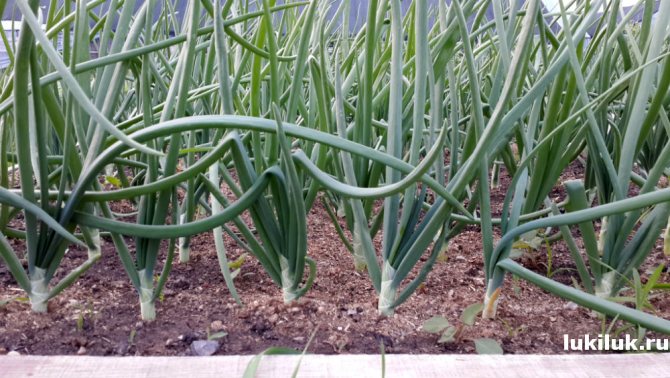

Weeding is an essential element to get a good harvest. By getting rid of weeds, you allow the bulbs to receive nutrients from the ground, creating space for growth.By loosening the soil, oxygen is supplied to the root system, which also has a beneficial effect on growth.
The need for weeding and loosening the soil is that in the process, more oxygen is supplied to the roots
Watering is carried out as the soil dries up; complex formulations are used as fertilizers. To accelerate growth a few weeks after planting, it is allowed to use mullein or dissolved bird droppings.
A month later, the culture is fed with urea (15 g), superphosphates (15 g) and potassium salt (40 g). Everything is diluted in water and added to the beds when watering.
The pallor of the leaves and poor growth are reminiscent of a lack of nitrogen. The resulting blackness indicates that there is not enough phosphorus for the plants.
It is forbidden to use fresh manure as a feeding component.
Onion planting rules Stuttgarter Riesen
If you follow a certain planting algorithm, you can get a good harvest even from the smallest area:
- Seeds of high-quality onion Stuttgarter are soaked for a day in warm water. The water is changed periodically. This is done in order to remove excess essential oils from the seeds, which prevent the rapid germination of seeds.
- After soaking, the seeds are slightly dried. This is done on a paper towel, napkins, or toilet paper.
- For convenience, during planting, the seeds are powdered with chalk, but this is not necessary.
- The grooves are moisturized.
- The onions are planted densely, and after germination they are thinned out, leaving 5-7 cm between the plants.
- Watering is not carried out immediately after planting, as a crust may form, which will impede germination. In very hot weather, drip irrigation of plantings is recommended.
- For the winter, the ridges are mulched with peat, dry grass or fallen leaves.
The beds must be broken through from weeds in time and loosened for better ventilation of the onion rhizomes. The depth of loosening is required small, so as not to damage the young bulbs. The soil should not dry out, because this will affect not only the yield, but also the taste of the vegetable. When growing onions Stuttgarter Riesen, special care does not require large expenditures, both physical and material.
Diseases and pests
This onion variety perfectly tolerates diseases, resists pests. He is not afraid of powdery mildew. The most likely cause of onion diseases can be poor-quality planting material. For this reason, seeds should be purchased in special stores, before planting, they should be treated with a manganese solution. To scare off parasites on onion beds, it is recommended to sow a small amount of dill.
Read more: Hydrangea in Siberia planting and breeding care - Flowers365
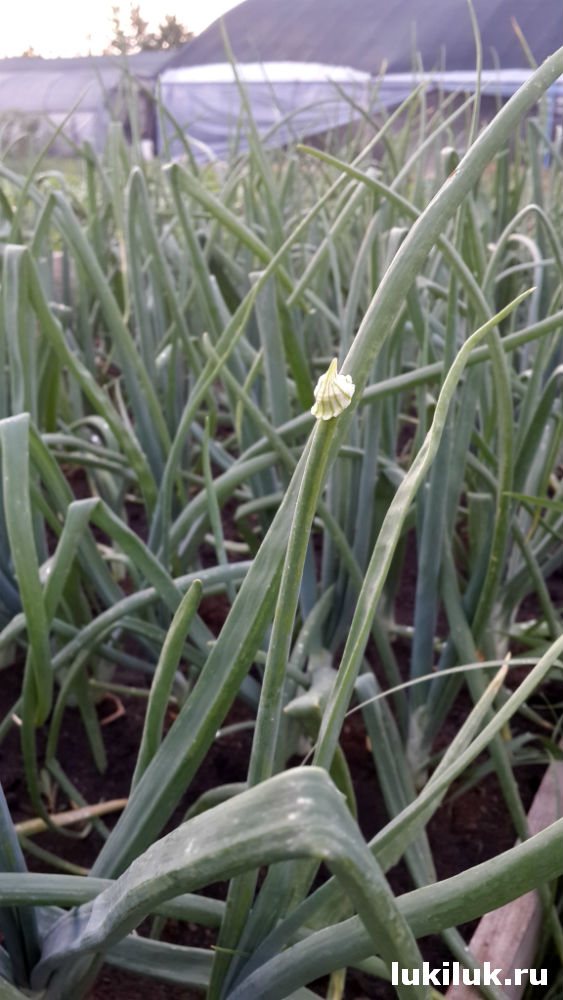

As mentioned above, the Stuttgarter Riesen onion has a high resistance to many diseases. Powdery mildew belongs to one of them. In order to avoid unwanted problems with diseases, you need to worry about this in advance - to carry out a disinfecting procedure for seeds and seedlings. In addition, you can sow dill next to the onion or alternate the onion beds with the carrot beds. It is so good to deal with various pests.
As you can see, growing Stuttgarter Riesen onion sets is quite simple. Any beginner can handle such a process and at the same time get a fairly large harvest.
Harvesting and storage rules
Before harvesting, watering is reduced, then it stops altogether so that the onion can ripen. You can harvest when the foliage turns yellow and withers. Do not keep the bulbs in the ground for a long time, so that they do not start growing again.
Storing Stuttgarter onions in bundles
The harvested onions are dried, sorted, and the root system and leaves are removed.
First of all, you should use unripe bulbs. For storing the seed, boxes with sand placed in the basement are used. If moisture appears, the onion must be dried again.
The cultivation of this onion variety is not difficult. By observing all the requirements, you can get excellent harvests.
Care methods
Culture care is not difficult and not troublesome. For onions, timely watering, fertilization and plowing of the top layer of the earth are important.
Watering
Water the plants depending on the soil condition and weather conditions. On hot days, onions need frequent and abundant irrigation (every 4-6 days), and on cloudy and damp days it is best to water as little as possible. Irrigation procedures should be carried out before the beginning of July and stopped. This will allow the bulbs to dry out. Watering is done in the evening and with warm water.
It is necessary to loosen and remove weeds regularly after irrigation procedures. It is necessary to fluff up a not very thick layer of earth so as not to injure the bulb.
Top dressing
If the land on the site is fertile, then the plant is rarely fed, and on poor soils, nutrients are applied once a month. The first feeding is carried out 12-15 days after planting the culture in a permanent place. You can feed it with both mineral complexes and organic matter.
When using organic fertilizers, it is highly undesirable to use fresh manure, which can adversely affect the ripening of the bulb and can provoke the development of diseases. If the soil is poor in nitrogen, then you can water the bed with ammonia - it is able to destroy the pests that have appeared.
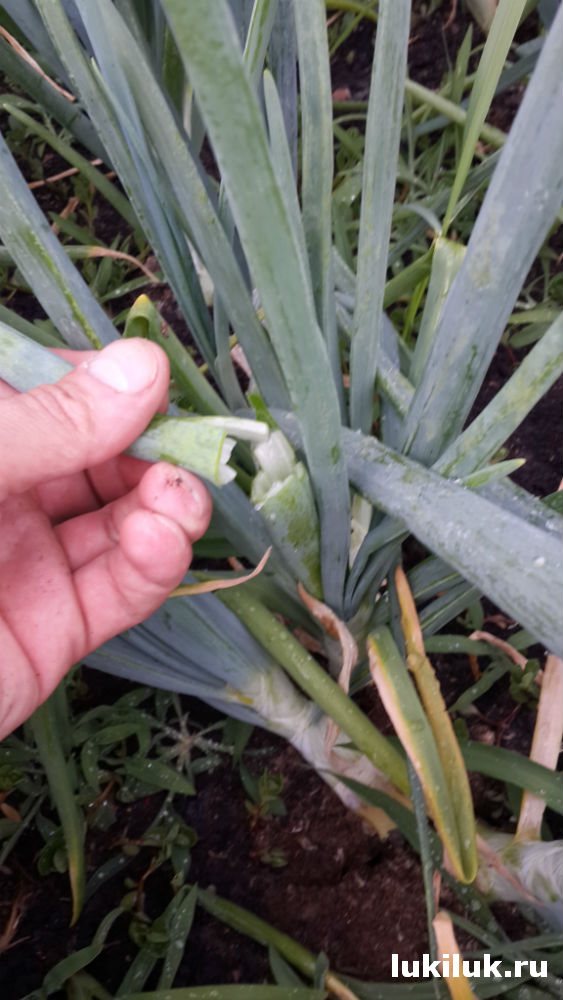

The Stuttgarter Riesen variety is resistant to various diseases. When buying high-quality planting material, there will be no problems with growing. The only thing that can provoke the development of the disease is poor care, namely stagnation of moisture, which causes rotting of the bulb. For preventive purposes, a pre-plant disinfection procedure will suffice. To ward off pests from the garden, you can plant dill next to it. A path of salt, poured in the aisle, will ward off an onion fly.
How to plant?
In the southern regions, Stuttgarter onions can be planted with nigella. The seeds are preliminarily kept in an antiseptic solution. Use potassium permanganate, hydrogen peroxide, boric acid. It is recommended to bring the seeds to maturity, but do not wait for the sprouts.
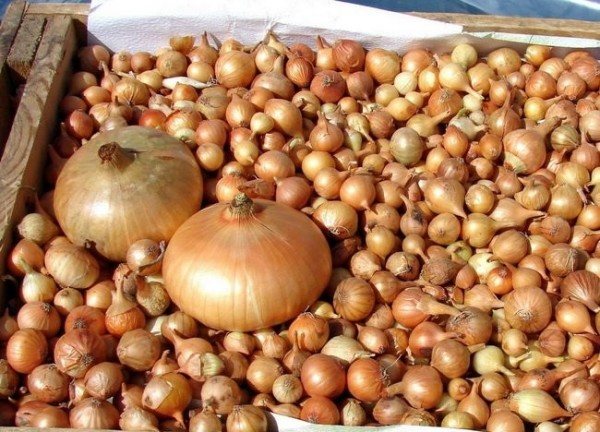

They can break during sowing. For ripening, the nigella is placed in a damp cloth and placed in the refrigerator. The napkin is opened daily to ventilate the seeds. When they swell and increase in size, sowing is carried out.
Sowing time depends on soil temperature. It should warm up to 5 C. The depth of the grooves is 3 cm. Sand or sawdust and ash are placed on the bottom. The filling of the nigella is carried out to a depth of 1 cm.
The seeds are covered with a mixture of peat and sand. It is a mulch that retains moisture well. It is loose, so it will be easier for seedlings to rise.
In cold regions, Stuttgarter onions are planted with sevk or seedlings. Sevok is preliminarily recommended to be treated with ash to prevent the development of fungus between the scales.
The sevok is deepened by 3 cm, leaving a neck on top. The distance between the bulbs is left at 10 cm. They are covered with mulch to prevent the development of diseases such as cervical rot.
View this post on Instagram
Publication by Tatiana Gratulevich (@tngratulevich) Jul 13, 2020 2:13 am PDT
Gardeners get good yields when planting seedlings. It is grown in a greenhouse at a temperature of 20-25 C. It is recommended to harden the seedlings before planting. She is taken out to the garden plot so that the seedlings get used to the new conditions.
More on the topic: What kind of care does the Golden Semko onion require?
Planting is carried out in spring, when the air temperature rises to 15-18 C. For planting, seedlings with 4-6 leaves are used. They are placed on the garden bed in 10-15 cm increments.

